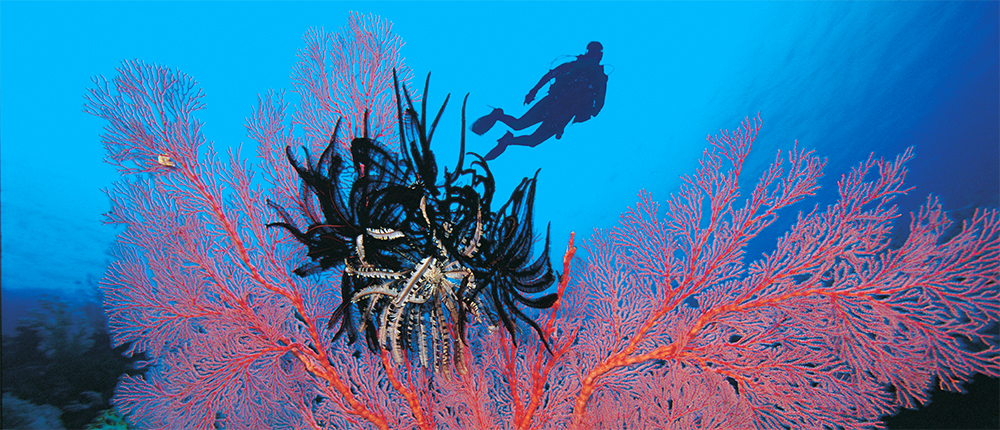Gorgonians Galore
Tour Wakatobi’s sea fan garden
Each of Wakatobi’s 40-plus dive sites offers a different reward. Some are known for large schools of fish, others for dramatic profiles, rare marine life or unique coral formations. And then there are the sites covered in gorgonians, more commonly known as sea fans. These simple marine invertebrates may not seem like the most exciting things found on the reef, but when they grow large, or blanket a reef in a dense coating of undulating color, sea fans can become quite the visual treat. Sea fans are a common sight on many reefs, but on a special few, they become a signature attraction.
Garden varieties
One of the best places to take in the full range of sea fans that thrive on Wakatobi’s reefs is the site known as Fan Garden. This garden of gorgonians is located on the north side of the expansive Sawa Reef formation. Here, the shallow reef top transitions abruptly to a wall, then becomes a steep slope as depths increase. What makes this site special is not only the profusion of sea fans—there’s hundreds, maybe thousands—but also the variety.

Snorkelers can see many types of sea fans in the shallows on Wakatobi’s reefs, along with numerous varieties of fish flitting in and around the fans. Photo by Marco Fierli, marcof8.com
At snorkel depths, the reefs are dominated by a mixture of stony corals and large patches of leather coral. Only a handful of small branching species of soft corals manage to claim a foothold at these depths. The main attraction here in the shallows are the multitude of small, colorful fish that flit about, and form cloud-like schools above the corals.
Follow the wall to depths of 10 meters/33 feet, and the soft corals take over. Here, the vertical faces are covered in dense growths of undulating, multi-hued gorgonians. Some have a classic fan-like profile, while others present a more bush-like shape, with multiple branches radiating from the base. An observant diver may notice that these branching varieties have large, clearly visible polyps arrayed in octagonal patterns.

Some sea fans have a bush-like shape with smaller projections radiating from the sides of the fan. Photo by Walt Stearns
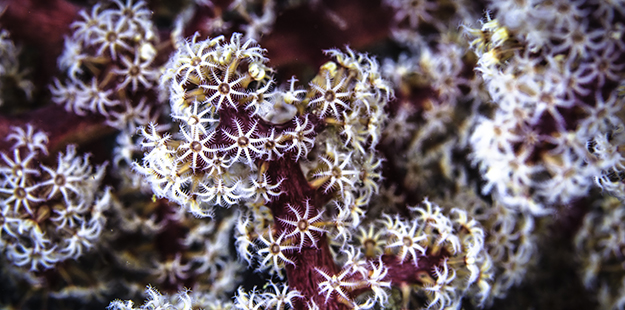
Look closely to observe a sea fan’s polyps, arrayed in octagonal patterns. Photo by Wayne MacWilliams
Like all gorgonians, these creatures are filter feeders. But in the clear waters of Wakatobi, where the shallow and mid-depth reefs receive ample sunlight, they hedge their bets by growing an internal crop of zooxanthellae algae to supplement the morsels snagged from the passing waters.
Another signature attribute of these mid-depth fans is their ability to go with the flow. Being able to bend and sway with moving water is important to a fan’s survival on reefs affected by currents and wave action. Wakatobi sites don’t experience surge, but there are tidal currents on that run from mild to brisk. The fans that best adapt to this ebb and flow are the Holaxonia, which have internal skeletons formed from a flexible, horny substance called gorgonin.
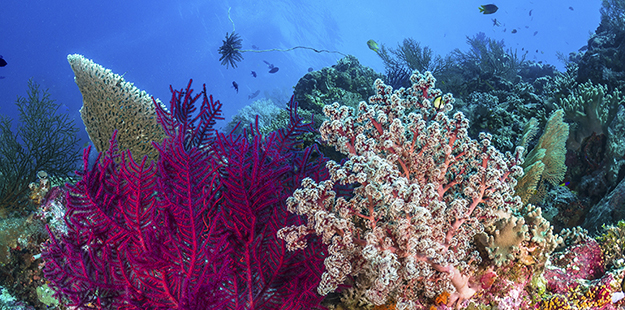
The ability to bend and sway with moving water is important to a fan’s survival on reefs. Photo by Wayne MacWilliams
When the sun is out and the water is moving, the wall at Fan Garden becomes a mesmerizing study in movement and color. The only thing that might distract you from the show is the arrival of a school of large humphead parrotfish, which are regular visitors to this site.
Your biggest fans
The scenery at Fan Garden changes once again as you move deeper. By the time you reach depths of 30 meters/100 feet, the true fan-shaped corals take over, and they start to get big. Like most things in nature, there’s an organic logic to both the size and shape of these fans. Down in the depths, the currents are usually milder. This means fan need to spread out to capture a larger share of passing nutrients. And without fast flows of water to contend with, the fans can expand surface areas without fear of being damaged by the flow. Many of the larger, flatter species of fans are members of the Scleraxonia suborder of gorgonians. Rather than flexible gorgonin skeletons, their supporting structures are formed from tightly grouped calcareous spicules, which are more rigid in nature. It is these same tiny spicules that give sea fans their vibrant colors.
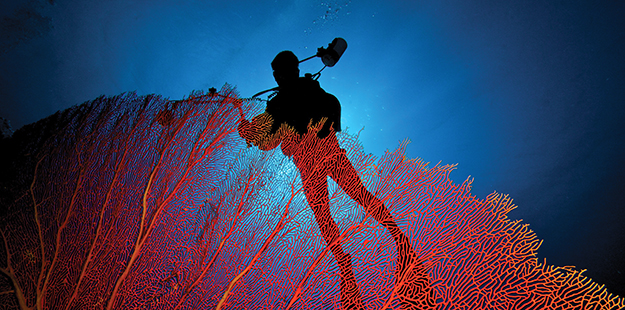
On deeper sections of sites like Fan Garden, divers may encounter fans that spread more than six feet across. Photo by Frank Owens
On the deep sections of Fan Garden, divers may encounter fans that are only a few inches thick, but spread more than six feet across. These are very old organisms, slow growing, and capable of living for a hundred years or more. Researchers sometimes study the growth patterns of these sea fans to gain clues to historic climate patterns and changes in the ocean environment.
A closer look
Move in and focus on the surface of a sea fan, and you may be pleasantly surprised, as small fish and crustaceans seek shelter among the branches. A more frequent find is the longnose hawkfish. This colorful little character often sticks close to the surface of a fan, and its orange-and-white checkerboard coloration makes a great subject for macro images.
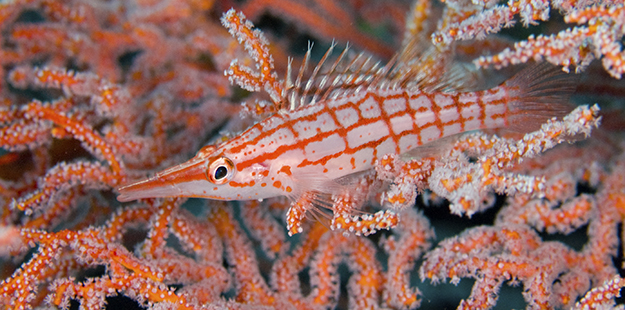
The longnose hawkfish will stick close to a sea fan’s surface and make for a great macro subject. Photo by Wakatobi Resort
A number of small crustaceans also cling to sea fan branches, though it may take some careful study to recognize some of the better camouflaged specimens, as they will develop colorations, and even body textures that mimic that of the fan. More about the hidden life within Wakatobi’s sea fans here.
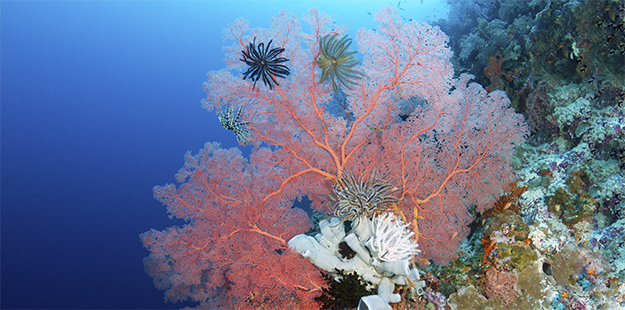
Crinoids will often make their way to the outer edge of fans, where they can extend their feather-like arms to capture passing bits of food. Photo by Walt Stearns
Crinoids are easier to spot, as these primitive creatures will make their way to the outer edge of the fan, where they can extend their feather-like arms to capture passing bits of food. Close cousins to the crinoids are brittle stars, which prefer to lay flat against the face of the fan and capture their share of the passing bounty.
The most prized finds on the sea fans of Wakatobi are pygmy seahorses. Of the seven species of pygmies known to science, four can be found at Wakatobi. It takes a keen eye to locate these tiniest members of the genus Hippocampus, which can be smaller than a fingernail.
Has your interest in diving with sea fans piqued? Maybe it’s time to discover this and the other unique treasures that await on the reefs of Wakatobi. Contact us at office@wakatobi.com, or complete a quick trip inquiry at wakatobi.com.
Visit us on Facebook.


